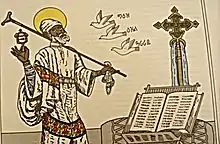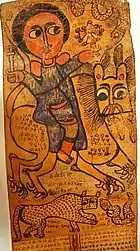Yared
Saint Yared (Ge'ez: ቅዱስ ያሬድ; April 25, 505 – May 20, 571 AD)[2][3] was an Ethiopian composer from Axum, Ethiopia, a pioneer of the traditional music of Ethiopia and Eritrea and creator of religious music for the Ethiopian Orthodox Church, Eritrean Orthodox Church, and the use in liturgical music, as well as the Ethiopian musical notation system. Additionally, he composed Zema, or the chant tradition of Ethiopia, particularly the chants of the Ethiopian-Eritrean Orthodox Tewahedo Churches, which are still performed today. He is regarded as a saint of the Ethiopian-Eritrean Orthodox Church with a feast day of May 19. His name is from the Biblical person known in English as "Jared" (Book of Genesis 5:15).
Saint Yared | |
|---|---|
 | |
| |
| Born | April 25, 505 Axum, Tigray Region Ethiopia |
| Died | May 20, 571 (aged 66) Semien Mountains, Ethiopia |
| Venerated in | Ethiopian Orthodox Tewahedo Church Eritrean Orthodox Tewahedo Church Ethiopian Catholic Church Eritrean Catholic Church[1] |
| Feast | May 19 |
| Attributes | Old man wearing traditional attir, and holding walking stick (mequamia), tsenatsel in front of Deggua book and three chants: Ge'ez, Ezel and Araray represented in terms of doves |
| Part of a series on |
| Oriental Orthodoxy |
|---|
 |
| Oriental Orthodox churches |
|
|
Life and role
Yared was born on April 25, 505 AD in the village of Axum, Tigray, Ethiopia from his mother Tauklia and his father Adam. When he reached six, his parent gave him tutelage of Yishaq, who was a teacher of Axum. Under his instruction, Yared completed alphabet and Psalms. Yishaq brought Yared back to his parent and his father died. Unable to raise him, his mother Tauklia left him to his brother Abba Gedeon, who was a parish priest. Gedeon was a teacher of Old and New Testament in Saint Mary of Sion and he begun translating Holy Scriptures into Ge'ez from Hebrew and Greek. At that time Yared was in poor education and unable to acquire knowledge, which led him severe punishments and mockery at school. Aware of his failure, Yared decided to go on to his uncle's birthplace Medebai Welel. Due to heavy rain, Yared sheltered under a nearby tree in place of Murade Qal.
Pondering his life, Yared rested and noticed a caterpillar climbing the tree to eat leaves. The caterpillar continued to fall down, but eventually it succeeded to reach its destination. Yared wept and returned to Gedeon and pledge him not to offend. Gedeon began teaching Psalms. Yared subsequently moved to Saint Mary of Sion and prayed everyday to God. When Yared was fourteen, Gedeon died; Yared took his mastering position.
He then returned to Axum at the age of nine, becoming the chief priest in Holy Ark of Sion. Soon after, Yared composed "Ariam".
While at Axum, Yared brought into fruition the concept of traditional musical instruments like tsenatsel, begena, masenqo, inzira and kebero through divine manifestation. Yared created musical notations and alphabets, as well as mequamia, a walking stick used by elder clergies during liturgy.
During the 14-year rule of Emperor Gebre Meskel, the son of Emperor Kaleb, Yared became a dominant musical figure in Axum. He denounced the greatest poet and the Emperor favored him. Soon after Yared composed Zema, resulted in his succession in church service.
Yared become a pioneer of observing Hossana, also called Palm Sunday in Axum. He divided hymns into four parts: winter, summer, autumn and spring. He completed a book Deggua, De'guaa in Tigrinya, which means "lamentations". Deggua divides into three chanting modes: Ge'ez, Ezel, Araray. Ge'ez relies a plain chant for ordinary days, Ezel is increased measured beat for funeral and Araray is a free mode, light beats for festivals. The highest part of Deggua is Mahlet Yared (hymn of Yared). Those three chants represent the Trinity.
Yared also composed ten tones with notations, unlike the European modes consisting of six notes. Yared then developed their arrangements calling "Seraye", which signifies hymnary guideline. The glyphs of notations consist of dashes, dots and curves. Tsome Deggua is written for Lent, Me'eraf is sung for Sabbath vigils, Zimare is for Holy Communion, Mewasit is for funerals, requierems and Eastern Eve and Quidase is for Communion. These books spend nine years in order to complete.
The Nine Saints, who expelled by religious persecution from Byzantine Empire and reached Ethiopia in the 5th century, met with Yared, whom he visited individuals churches and aid them to build with assistance of Axumite Emperors. Yared also consecrated Debre Damo churches founded by Abune Aragawi. One place where Yared successfully gave mastery is St. Qirkos in Lake Tana.[4]
Later life and death
On the coronation of Gebre Meskel, Yared placed a wreath of flower to crown on him. The event is found in Deggua.
Yared died at the age of 66 on May 20, 571 AD in a cave in the Semien Mountains. He had been traveling to teach.[4]
See also
References
- "Kidane Mehret Ge'ez Rite Catholic Parish The Ge'ez Rite". Kidane-mehret.org.
- Chavis, Charles L. (2011-04-05). "Yared (Saint), 505-571 AD". Retrieved 2020-05-03.
- Giday, Belai (1991). Ethiopian Civilization. B. Giday.
- "About St. Yared - St. Yared Ethiopian Cuisine & Coffeehaus - Indianapolis IN". www.styaredcuisine.com. Retrieved 2020-09-04.
External links
- A brief History of Saint Yared
- Biography of Saint Yared
- Yelibenwork Ayele. Honoring St. Yared, Ethiopia’s father of music. Ethiopian Reporter, Saturday August 30, 2008. (dead link)
- Charles L. Chavis Jr. Saint Yared
